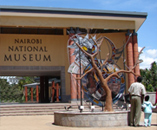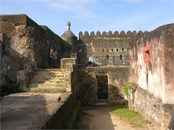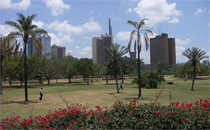Kenya
City Of Kenya
- Nairobi
- Mombasa
- Malindi
- Chogoria
- Embu
- Eldoret
- Garissa
- Homa Bay
- Isiolo
- Kajiado
- Kakamega
- Kendu Bay
- Kericho
- Kilifi
- Kissi
- Kisumu
- Kitale
- Kitui
- Kwale
- Lamu
- Limuru
- Lodwar
- Maralal
- Marsabit
- Meru
- Naivasha
- Nakuru
- Nanyuki
- Narok
- Nyahururu
- Nyeri
- Taveta
- Thika
National Parks
- Aberdare
- Amboseli
- Hell's Gate
- Ndere Island
- Kerio Valley
- Nakuru Lake
- Malka Mari
- Marsabit
- Meru
- Mombasa
- Mount Kenya
- Mount Longonot
- Nairobi
- Ruma
- Tsavo East
- Tsavo West
- Sibiloi
- Arabuko Sokoke Forest
- Victoria Lake
National Reserves
- Arawale
- Boni
- Dodori
- Tana River Primate
- Kakamega Forest
- Kiunga
- Kora
- Rahole
- Masai Mara
- Mpunguti
- Shimba Hills
- South Kitui
Marine Parks
Marine Reserves
Provinces of Kenya
Museums, Monuments and Sites in Kenya

Nairobi National Museum
Keeps some of the most famous collections of history, culture and art from Kenya, as prehistoric artifacts, more than 900 stuffed birds and animals, fossils from Turkana Lake, exhibitions of ethnic tribal groups, watercolors of flowers and plants and a collection of rocks and minerals. In the section Hominid Vault contains the ''first men''- a collection of bones and fossils from the pre-historic era.
Karen Blixen Museum
Located on the suburbs of Nairobi, has acquired an international reputation after the release of the film''Out of Africa'' based on the autobiografie of Karen. The museum is a shop of handicrafts, posters and postcards, books and other souvenirs of Kenya

Fort Jesus Museum - Mombasa
Built in 1593 by the Portuguese and used as barracks for soldiers between 1837 and 1895, the year that was converted into a prison. In 1958, was declared National Park and became museum in 1962. It keeps excavations finds and other items donated by individuals, the wreck of ''Santo Antonio da Tanna'' which sank in the port of Mombasa in 1697 and ceramics recovered from the coast.
Lamu Museum
Located on Lamu Island, was built between 1813 and 1821 as a fortress, and from 1910 until 1984 served as a prison. The permanent exhibition on the ground floor is divided into three sections: marine, freshwater and terrestrial, each one divided into its different ecosystems. Upstairs are the offices laboratories, a shop and a restaurant.
Malindi Museum
It hosts temporary exhibitions and is an information center for attractions and events in Malindi and on the explorer Vasco da Gama and his arrival in 1498, a collection of images, objects and artifacts of the past and present of Malindi.
Kisumu Museum
Holds exhibitions of cultural history, collections of species of flora and fauna, a traditional Luo house, Luo traditional artifacts. Here you can get information on the culture of western Kenya. Attached to the museum are the sites and monuments of historical importance such as Fort Tenan, Songhor, Thimlich Ohinga and Rusinga islands.
Kitale Museum
It is known as Stoneham Museum, the name taken by the naturalist Hugh Stoneham who lived in Kitale and had a collection of insects, animals and books. The museum also has ethnographic materials collected from surrounding ethnic groups.
Loiyangalani Museum
It is located in the desert on top of a hill overlooking Turkana Lake and focuses on the lives of eight communities that are living in the area and the natural environment of the place.
Gede Museum
The ruins of Gede are the remains of a traditional Swahili town, built in the twelfth century and rebuilt in the XV or XVI century, abandoned in the seventeenth century. Among the ruins are the mosques, a palace and the houses that are submerged in the forest.
Kalenguria Museum
Keeps books and documents in a memorial library in honor of all the heroes who participated in the struggle for the independence of Kenya, artifacts and photographs collected on the Pokot people, finds that reveal the pre-colonial history, the slavery, the arrival of Europeans, the African resistance to the colonial domination and the activities of pioneering nationalists
Meru Museum
Keep the traditional culture and practices of Meru people and has a garden with shrubs and indigenous medicine grasses, traditional huts, an outdoor platform for dance, music and kiosks for selling.
Kabernet Museum
Has four galleries with exhibitions of culture, environment and indigenous knowledge. The main attraction is the exhibition on the culture of Keiyo / Marakwet, Samburu, Pokot, Nandi and Kipsigis. There are also exhibits from pre-colonial, colonial and post-independence period.
Narok Museum
Holds exhibitions of photos and artifacts to preserve the beauty and the strength of the traditional culture of the Maasai and Maa people, paintings and photographs depicting the traditional lifestyle.
Rabai Museum – Mombasa
Known as the place where Christianity began in Kenya, is a monumental recall of events during the advent of the first missionaries.
Tom Mboya Mausoleum– Kisumu
Is the burial place of Tom Mboya, built in his honor, here are details about his family and his international role as an agent of the Kenyan government.
Hyrax Hills National Monument – Nakuru
Is an area of archaeological research and a reference point for the investigation of prehistory.

Uhuru Garden – Nairobi
Is the largest memorial park in Kenya, in the Swahili language, Uhuru means independence. The name of the park has been given to commemorate the struggle for independence. As attraction in the garden there is a tower of 24 meters with a pair of hands covering a dove which means peace. The monument's column is on a triumphant statue of a group of freedom fighters raising a flag.
Jumba la Mtwana – Mombasa
The name in Swahili means "the big house of slaves". Within the area are four mosques, a tomb and four houses: the House of cylinder, The House of Food, The House of Many Wells and the Great Mosque.
Mnarani – Kilifi
The site contains the ruins of two mosques and a group of tombs. The first mosque was built around 1475, while the second in about 1500, were destroyed in the early seventeenth century.
Siyu Fort
Is the only fortress built by the natives. The local tradition says that was built by a Siyu leader in the nineteenth century as a safeguard for residents from Arab domination. Inside are the remains of a villa of stone built for himself. The fort preserve the remains of the tombs and magnificent mosques.
Koobi Fora
The site is located on the east of Turkana Lake with an area of 1800 square kilometers and contains fossils of hominids from the Pleistocene and Pliocene period (about 5 million years ago) but also animal and plant fossils . The first Australopitechus skull was found here by the famous paleontologist Dr. Richard Leakey, but it was also founded fossils of Homo habilis and Homo erectus.
Songhor
The site is located in the Nyando district of the Nyanza Province and is spread over an area of 78 hectares. There are fossils of the eight species of animals and hominid from the Miocene period dating back to about 19 million years ago.
Takwa – Lamu
These are the ruins of a flourishing Swahili city abandoned in the seventeenth century. You can see the ruins of the only mosque with a large pillar that symbolizes the burial of Sheikh under the walls
Thimlich Ohinga
Located in the Migori district of the Nyanza province is a "terrible dense forest." The stone structure is high by 1 to 4.2 meters and was built without mortar or sanding. The materials found on the site are older than 500 years and it seems that was built by the Bantu population.
Olorgesailie
Is a basin of a lake that existed during the latter part of the Middle Pleistocene period, approximately 200,000 and 100,000 years ago. It preserve biological and cultural items that proof the evolution of mankind thanks to heavy fall of volcanic alkaline ash. The subsequent movement of the earth have stratified the fossils giving us the opportunity to study them. Most important of all fossils in the area are the human instruments who give importance to the international site.










